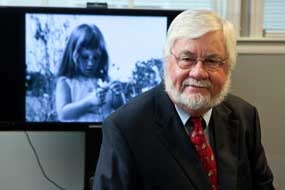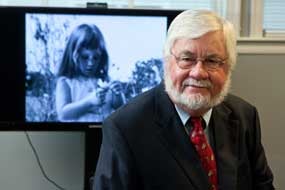 KINGSTON, R.I. – September 23, 2013 – Attention political junkies, students and researchers: Do you want to see how presidential ads have been transformed over the decades into slick attack pieces and apple-pie bits on the virtues of each party’s favorite candidate?
KINGSTON, R.I. – September 23, 2013 – Attention political junkies, students and researchers: Do you want to see how presidential ads have been transformed over the decades into slick attack pieces and apple-pie bits on the virtues of each party’s favorite candidate?
Then check out what may be the world’s largest private video archive of presidential campaign ads, which have been donated to the University of Rhode Island by L. Patrick Devlin, URI professor emeritus of Communication Studies.
Devlin, who taught, researched and published on political advertising for nearly 40 years at URI, donated his entire collection, which begins with 29 Dwight D. Eisenhower ads and ends with 480 primary and general election ads from 2012.
Three hundred and twenty VHS tapes and 30 DVDs, containing ads that run from 30 seconds to 5 minutes, are now housed in the Robert L. Carothers Library and Learning Commons.
The collection contains:
• Ads that were never aired for, Ronald Reagan, 1980, Michael Dukakis, 1988 and Bob Dole, 1996.
• Third party candidate ads for John Anderson, 1980, Ross Perot,1992 and 1996, and Ralph Nader, 2000.
• Political action committee and party ads, such as Willie Horton, 1988, Ashley by the Progress for America Voter Fund, 2004, and Swift Boat veterans, 2004.
• Prominent primary campaign ads, George McGovern, 1972, Ted Kennedy, 1980 and Hillary Clinton, 2008.
• Obscure primary campaign ads, Fred Harris, 1976, Pat Buchanan, 1996, and Herman Cain and Michele Bachman, 2012.
 Because most of the recordings are on VHS and other formats, Sarina Rodrigues, associate professor of libraries who oversees URI’s Special Collections unit, is seeking a grant to digitize the vast collection.
Because most of the recordings are on VHS and other formats, Sarina Rodrigues, associate professor of libraries who oversees URI’s Special Collections unit, is seeking a grant to digitize the vast collection.
Devlin’s ad-capturing odyssey began in 1972 when he was on sabbatical in Washington, D.C. where he was researching speechwriting, and was trying to catch up with speechwriters for Richard M. Nixon and George McGovern.
“They were impossible to find, and as I was watching the various ads on TV, I realized I could interview the ad makers,” said Devlin, an expert on political communication who focused on political debate, speechwriting and presidential campaign commercials. “They talked to me, and they sent me their ads. That’s when it began.”
“Selling copies of these recordings to political science professors became a cottage industry for me,” Devlin said. “But the Internet ended my endeavor because anyone can look at ads anytime and they are there forever.
“I wrote two books in my career,” he said. “One sold 3,000 copies and the other sold 287. My book-writing career was not that successful, but my ad work became a centerpiece of my academic career.“
From his 40 years of research Devlin has observed the following trends:
• Television campaigns are increasingly expensive. In 1992, Clinton, Bush and Perot spent $130 million, with Perot spending $40 million of his own money. By 2012, Mitt Romney spent $500 million, all of it without public financing but with the help of political action committees. Obama spent about $400 million. Obama rejected public financing in 2008.
• Campaign ads are becoming increasingly negative. In 1952 and 1964 respectively, Eisenhower and Lyndon B. Johnson used negative themes in two-thirds of their ads, but in 2012, both campaigns’ ads were 90 percent negative.
• Voter targeting has moved from undecided to partisans.
• Ad buys in battleground states have replaced national buys. Never has
so much money been spent on ads meant to be seen by so few.
• Most ads are 30-second pieces. Prior to 1980, almost 40 percent of the
ads were 5-minute spots.
And now most important, Devlin said if a candidate is not using social Media, he or she is not going to win. “Traditional advertising is being shoved aside by social media. It’s a way to megaphone your message to individuals.”
COMPELLING POLITICAL AD: L. Patrick Devlin, URI professor emeritus of Communication Studies, stands near a TV image of the famous “Daisy Girl” ad run by incumbent Lyndon B. Johnson during the 1964 presidential campaign.
PRESIDENTIAL MESSAGES: L. Patrick Devlin, URI professor emeritus of Communication Studies, examines some of the items in his private video collection of presidential television campaign ads, which he recently donated to the URI Carothers Library and Learning Commons.
URI photos by Joe Giblin.

